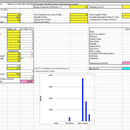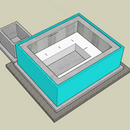Heat Loss Calcs for Superinsulated Hot Tub
Hi, I recently built a new super-insulated house and through that process learned a ton about building science, insulation, airtightness, etc. I am now working on an unconventional DIY hot tub project where the same principles are applying.
I am wondering if anyone can help me create a heat loss calculation and thus, an estimate of annual heating cost on a DIY concrete/stone hot tub?
Design temp (Northern Wisconsin) = -16°
Target hot tub temp = 102°
Dimensions = 10’6″ x 8’6″ (126″ x 102″) outside dimensions
Perimeter = 38′
Volume of entire envelop (including 10″ concrete walls) = 319 cubic feet
Wall is 10″ concrete poured wall with 4″ of XPS on outside
Walls are 43″ in height and are buried underground 50%.
No current insulation under slab, but I could add 1.5″ if it made a big difference.
Heating degree days at my location (degreedays.net) for base temperature of 102° = 21,560
I tried my hand using a calculator that I used for rough estimates on our home build. Treating the entire thing like a basement with an insulated lid on it. Those calcs show a heat loss of 6,392 btu/hr.
Can someone help me verify the basic accuracy of this estimate?
Then, how do I transfer this into estimated cost to heat? There will be a 5.5kw electric heater (Balboa BP7) and a pump to circulate the water. I am not sure what specs need to be known about the heater to estimate this part.
Thank you!
Mike
GBA Detail Library
A collection of one thousand construction details organized by climate and house part











Replies
I'd like to also add that I have no idea how I might estimate the airtightness of a hot tub with a good quality 6" cover on.
There are two quantities you want to calculate. The first is how big a heater you need to maintain temperature on the coldest days. That is given in BTU/hr, that looks to be the number you already have. The second quantity is the annual heating cost, which is given in BTU. To calculate that, the assumption is that every degree-hour takes the same amount of energy. If your tub needs 6,392 BTU/hr when it's 102F inside the tub and -16F -- 118 degrees -- that's 54 BTU per degree-hour.
If you have 21,560 degree-days of heating, that's 517,440 degree hours. At 54 BTU per degree-hour that's 28 million BTU per year. That's about 8200 kWh of electricity or about 250 gallons of heating oil.
My opinion is that treating it as a basement is underestimating your heating needs. With only about 22 inches below ground you're not getting much insulation from the ground. I would re-run it assuming the whole thing is above-ground.
Thanks DC Contrarian!
First, how do I do this?
"The first is how big a heater you need to maintain temperature on the coldest days."
Second:
I've recreated the spreadsheet as if the entire thing is above ground, but it seems to actually have made the heat loss go down. For that reason and for verification, would you know how to do a basic calculation to confirm or deny what this calculator is spitting out? I just want to make sure this is roughly accurate and I am not way off.
Is heating water vs. air different in any way in doing these calcs?
Under Slab
Lastly, it does look like if I add even 1.5" below the slab, it reduces the energy quite significantly. From 5,478 to 3,242. Can I put something of this weight on top of 25psi foam?
Is this math correct for foam under slab?
- Concrete is 150 lbs. per cubic foot
- Height of hot tub = 43" walls + 6" slab = 49"
- 1 square foot = 4.02x150=603 on each square foot / 144 square inches = 4.19 pounds per square inch
- If I use 25 psi foam, I should be well-beyond okay for the weight of this entire thing on top of foam, right?
The formula for heat loss through an insulated wall is:
Heat loss (in BTU/hr)= area (in square feet)* temperature difference between the two sides of the wall (in F)/ R value
To get a ballpark number, figure out the heat loss for the six sides and add them up. To size your heater you want to do the calculation for an outside temperature of your design temperature, -16F.
Thanks DC!
I ran those numbers as you suggested with 102° interior temp and -16° exterior. They're in the attached table.
- Did I use the right numbers for interior/exterior? What temps would I use for the slab since it is below the surface?
- Then I tried to follow your previous math trail to divide over degree days and estimate annual usage. Does it look like I did that right?
At first review, this "back of the envelope" approach yielded 2,265 btu/hr vs. the spreadsheet tool showing 3,242 btu/hr. Not wildly different.
Does that pass your sniff test for accuracy?
Any thoughts on foam below the slab/foundation and the psi question?
Thanks so much!
Most pools/hot tubs lose their heat through evaporation. Insulating helps for sure. A sealed lid helps tremendously more. I think it's between 80-90% of heat in pools/hot tubs is lost through evaporation.
Water takes 1 btu per degree F to heat one lb. It loses 970 BTUs when 1lb of water evaporates.
What I am particularly trying to answer is if I should put foam underneath the slab.
When I use the (what seems to be) more nuanced heat loss tool, foam takes the heat loss from 5,478 btu/hr to 3,242, a 41% reduction.
When I do the basic heat loss calc using U value x Wall area x Delta T, it says that no foam results in 15,035 btu/hr and 1.5" foam is 2,233 btu/hr.
I am trying to weigh the potential risks of putting foam underneath the slab foundation and understand what the energy cost is, but the heat loss calcs yield very different results.
I can't sign up for 15k btu/hr, but I don't have much of a problem with 5k btu/hr.
The heat loss to the ground is going to be different from the loss through the walls. The ground is roughly at the same temperature year-round so the loss is constant year-round and doesn't depend on heating degree-days. So it's a different calculation.
I have a similar hot tub in Central Texas. The OD are 8' x7'. The walls are all masonry and 10" thick. The base is 12" thick to allow for plumbing and extra rebar support (unit has over 600 feet of No. 5 rebar) You are wanting to use a 5 kva heater that I think in reality will be way too small. I run a 11 kva heater and need every kva to keep it hot in a texas winter. When i had an element go out it took almost 8 hours of heating a day to keep the tub at 102 degrees. With the 11 kva, 2 - 3 hours a day of heating will keep the tub at desired temp. I also have a very high end 5" cover, so it pretty well insulated for a hot tub. Also, once the masonry heats up, there is a pretty good thermal mass that doesn't cool very fast.